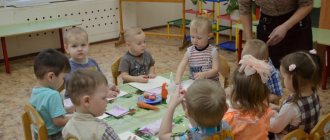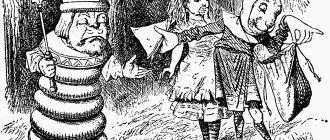methodology for conducting outdoor activities, educational and methodological manual (junior group) on the topic
Methods of conducting outdoor games in different age groups
Selection of games.
Games are selected in accordance with the objectives of education, age characteristics of children, their state of health, and preparedness. The location of the game during the day, time of year, meteorological, climatic and other conditions are also taken into account. It is also necessary to take into account the degree of organization of the children, their discipline: if they are not organized enough, then first you need to pick up a game of small mobility and play it in a circle. Gathering children for the game.
You can gather children for a game in different ways. In the younger group, the teacher begins to play with 3-5 children, and gradually the rest join them. Sometimes he rings a bell or picks up a beautiful toy (bunny, teddy bear), attracting the attention of the kids and immediately involving them in the game. With children of older groups, you should agree in advance, even before going to the site, where they will gather, what game they will play and by what signal they will start it (a word, hitting a tambourine, bell, waving a flag, etc.). In the older group, the teacher can instruct his assistants - the most active children - to gather everyone for the game. There is another technique: having distributed the children into units, offer, at a signal, to gather in designated places as quickly as possible (note which unit gathered the fastest). You need to gather children quickly (1-2 minutes), because any delay reduces interest in the game. Creating interest in the game.
First of all, you need to create an interest in the game in children. Then they will better understand its rules, perform movements more clearly, and experience emotional uplift. You can, for example, read poetry, sing a song on a relevant topic, show children objects and toys that they will encounter in the game. It is often possible to lead to the game by asking questions or asking riddles. In particular, you can ask: “What did you draw today?” Children, for example, will answer: “Spring, the arrival of birds.” “Very good,” says the teacher. “Today we will play the game “Migration of Birds.” Children of the younger group can be shown a flag, a bunny, a bear and immediately ask: “Do you want to play with them?” A short story read or told by the teacher immediately before the game also gives a good result. Organization of the players, explanation of the game.
When explaining the game, it is important to place the children correctly. The teacher most often positions children in the younger group as needed for the game (in a circle). He can build the older group in a line, in a semicircle, or gather them near him (in a flock). The teacher must stand so that everyone can see him (facing the children when forming in a line, in a semicircle; next to them, if the children are gathered in a circle). In the younger group, all explanations are made, as a rule, during the game itself. Without interrupting her, the teacher places and moves the children and tells them how to act. In older groups, the teacher announces the name, reveals the content and explains the rules before the game starts. If the game is very complex, then it is not recommended to immediately give a detailed explanation, but it is better to do this: first explain the main thing, and then, during the game, supplement the main story with details. When the game is played again, the rules are clarified. If the game is familiar to children, you can involve them in the explanation. The explanation of the content and rules of the game should be concise, precise and emotional. Intonation is of great importance. When explaining, it is especially necessary to highlight the rules of the game. Movements can be shown before or during the game. This is usually done by the teacher himself, and sometimes by one of the children of his choice. The explanation is often accompanied by a demonstration: how a car drives out, how a bunny jumps. The successful implementation of the game largely depends on the successful distribution of roles, so it is important to take into account the characteristics of children: shy, sedentary ones cannot always cope with a responsible role, but they must be gradually brought to this; on the other hand, you cannot always assign responsible roles to the same children; it is desirable that everyone knows how to fulfill these roles. In games with young children, the teacher first takes on the main role (for example, the cat in the game “Sparrows and the Cat”). And only then, when the kids get used to the game, does he assign this role to the children themselves. Even during the explanation, he appoints a driver and puts the rest of the players in their places, but counting rhymes can also be used for this purpose. Sometimes those who play the role of driver choose their own deputy. In the older group, the game is first explained, then roles are assigned and children are placed. If the game is played for the first time, then it is done by the teacher, and then by the players themselves. When dividing into columns, units, or teams, it is necessary to group strong children with weaker ones, especially in games where there is an element of competition (“Ball for the driver,” “Circle relay”). You can mark the playing area in advance or during the explanation and placement of the players. Equipment, toys and attributes are usually distributed before the start of the game, sometimes they are placed in designated places, and the children take them during the game. Conducting and directing the game.
The children's play activities are supervised by the teacher. Its role depends on the nature of the game itself, on the size and age of the group, on the behavior of the participants: the younger the children are, the more active the teacher is. When playing with younger children, he acts on an equal basis with them, often playing the main role, and at the same time directs the game. In the middle and senior groups, the teacher first also plays the main role himself, and then passes it on to the children. He also participates in the game when there is not enough pair (“Find yourself a pair”). The teacher's direct participation in the game raises interest in it and makes it more emotional. The teacher gives commands or sound and visual signals to start the game: hitting a tambourine, drum, rattle, musical chord, clapping, waving a colored flag, or hand. Sound signals should not be too loud: strong blows and sharp whistles excite small children. The teacher gives instructions both during the game and before its repetition, evaluates the actions and behavior of the children. However, you should not overuse instructions about incorrect execution of movements: comments can reduce the positive emotions that arise during the game. It is better to give instructions in a positive form, maintaining a joyful mood, encouraging determination, dexterity, resourcefulness, initiative - all this makes children want to strictly follow the rules of the game. The teacher suggests how it is more expedient to perform the movement, catch and dodge (change direction, slip or run past the “trap” unnoticed, stop quickly), reminds that poetry must be read expressively and not too loudly. The teacher monitors the children’s actions and does not allow long-term static poses (squatting, standing on one leg, raising arms forward, upward), which cause narrowing of the chest and poor circulation, and monitors the general condition and well-being of each child. The teacher regulates physical activity, which should increase gradually. If, for example, when the game is played for the first time, children are allowed to run for 10 seconds, then when it is repeated, the load is slightly increased; on the fourth repetition it reaches the maximum norm, and on the fifth or sixth repetition it decreases. The load can be increased by changing the tempo of the movements. Games of great mobility are repeated 3-4 times, calmer ones - 4-6 times. Pauses between repetitions are 0.3-0.5 minutes. During the pause, children perform easier exercises or pronounce words from the text. The total duration of the outdoor game gradually increases from 5 minutes in younger groups to 15 minutes in older groups. End of the game and summing up.
In younger groups, the teacher ends the game with a proposal to move on to some other activities of a calmer nature. In older groups, the results of the game are summed up: those who performed the movements correctly, showed agility, speed, ingenuity, intelligence, followed the rules, and helped out their comrades are noted. The teacher also names those who broke the rules and interfered with their comrades. He analyzes how he managed to achieve success in the game, why the “trap” quickly caught some, while others were never caught by him. Summing up the results of the game should be carried out in an interesting and entertaining way to create a desire to achieve even better results next time. All children must be involved in the discussion of the game. This accustoms them to analyze their actions, causes a more conscious attitude towards following the rules of the game and movements. Peculiarities of the methodology for conducting games in a mixed group.
In this group, games can be played simultaneously with everyone, or separately with younger and older children. If the game is played together, then it is selected according to the strengths of both children. The main role is played by older children. The teacher regulates physical activity, reducing it for younger children. More complex games with older children are played separately during walks. Outdoor games also differ: in the complexity of movements; according to the content of the plot; by the number of rules and roles; by the nature of the relationship between the players; by the presence of competitive elements and verbal accompaniment. Fun games are played with children of the first year of life (“Hide and Seek”, “Horned Goat”, “White-sided Magpie”, “Let’s go, let’s go”, “I’ll catch up”, etc.), which evoke sounds, movements, laughter in children, joy, pleasure. In the second year of life, plotless games are used (“Bring a ball, a toy”, “Raise your legs higher”, “Pass the ball”, “Roll down the hill”, “Catch up with the dog”, “Hurry up to me”, “Crawl to the rattle”, “Who’s next”, “Let’s hide the toy”, “Birds flap their wings”, “Catching butterflies”, “Trees are swinging”, “Steam locomotive”, “Bear”, etc.). In these games, children perform one movement (walking, throwing) at an individual pace, but gradually they move from individual actions to joint ones. Later, more complex movements are included in the games and the number of movements increases. The plots of the games are also becoming more complex. Outdoor games for kids are characterized by a simple plot (for example, birds fly and return home, cars drive and stop). The number of roles in the games of young children is insignificant (1-2). The main role is played by the teacher, and the kids portray the same characters, for example, the teacher is a cat, all the children are mice (“Cat and Mice”). In the games of older children, the number of roles increases (up to 3-4). Here, for example, there is already a shepherd, a wolf, geese (“Geese-Swans”), in addition, the roles are distributed among all the children. The number of rules gradually increases, and relationships between children become more complicated. In younger groups, the rules are very simple and suggestive in nature, their number is small (1-2), they are related to the plot, and follow from the content of the game. Following the rules comes down to acting on a signal: at one signal the children run out of the house, at another they return to their places. Over time, restrictions on actions are introduced: run away in a certain direction; if caught, move aside. In games with elements of competition, first everyone acts for himself (whoever manages to bring the object first), then collective responsibility is introduced: the competitors are divided into groups, the result of the entire team is taken into account (whose group hits the target the most times); competitions are held for the quality of execution (whose column can be built better; who never drops the ball), as well as for speed (who can reach the flag faster). Outdoor games for young children are often accompanied by words - poems, songs, recitatives, which reveal the content of the game and its rules; explain what movement and how to perform it; serve as signals for beginning and ending; suggest ri, “Horses”, etc.). Games accompanied by text are also given in older groups, and the words are often pronounced in chorus (“We are cheerful guys,” etc.) The text sets the rhythm of the movement. The end of the text serves as a signal to stop the action or to start new movements. At the same time, pronouncing words is a rest after intense movements.
Conducting outdoor games in different age groups
The child’s play activity begins to develop at an early age. In order for children to play fully, it is necessary to create a pedagogically appropriate external environment for them and select the right toys. Children of the second year of life are very active. To satisfy their need for movement, it is necessary to have a slide, benches, boxes and other aids on the site. Children should be given enough space to run, climb steps, slide down a slide, etc., play hide and seek and catch up.
In the games of children over one and a half years old, one can notice signs of imitation of adults. Taking this into account, the teacher involves them in games with the help of toys and tries to awaken interest with emotional, figurative explanations. In younger groups, story games and the simplest non-story games such as “Traps”, as well as fun games, are most often used. Children are attracted to the game mainly by the process of action: they are interested in running, catching up, throwing, etc. It is important to teach them to act exactly on a signal and obey the simple rules of the game. The success of the game depends on the teacher. It should interest children and give examples of movements. The teacher plays the leading role in the game himself or assigns it to the most active child, sometimes preparing one of the children from the older groups for this. It is important to remember that the driver only pretends to catch the children:
This pedagogical technique is used to prevent children from getting scared and losing interest in the game.
When conducting story games, it is recommended to use a technique that appeals to the child’s imagination. For this purpose, the figurative possibilities of the plot story are used. Here is a sample story for the game “Sparrows and the Car.”
The children sit on the chairs, and the teacher begins to tell: “Once upon a time there were little gray sparrows. On a clear sunny day they flew around the garden and looked for insects or grains. They flew up to the puddle, drank some water and flew away again. One day a big red car appeared and started blaring “beep, beep, beep.” The sparrows got scared and flew away to their nests. Let's play this game. You will be little sparrows. The chairs will be your nests, and I will represent the car. Sparrows, fly out! And as soon as the car sounds “beep-beep-beep,” all the sparrows should fly to their nests.”
This explanation takes less than a minute. The teacher plays with the children, playing both the role of a sparrow and the role of a car. Kids do not notice such a transformation. They enter into the character with pleasure, sometimes complementing it with individual actions: pecking grains and saying “peck-peck,” drinking water and squeaking “pee-pee.”
The teacher monitors the children’s figurative performance of actions, reminds them to use the entire playground in the game, fly beautifully, emotionally imitate movements, and act (if possible) on a signal. When playing, it is necessary to constantly remind children of the game image. Various attributes significantly enliven the game: hats with images of birds, car steering wheels, etc. When the game is played later, children are offered new options: the sparrows return to their nests, climb onto the bench (sit on the wires). By the end of the year, the role of the car can be entrusted to the most active child.
For the younger group, games with text are recommended. When playing games such as “Hare”, “Train”, etc., the teacher expressively reads the text, accompanying it with appropriate movements. Such games develop a sense of rhythm in children. The children, listening to the teacher, try to imitate his movements.
By the age of four, children accumulate motor experience and movements become more coordinated. Taking this factor into account, the teacher complicates the conditions of the game: increases the distance for running, throwing, and jumping height; selects games that exercise dexterity, courage, and endurance. In the middle group, the teacher already distributes roles among the children. The role of the leader is initially assigned to children who can handle it. If a child is unable to accurately complete a task, he may lose faith in his abilities and it will be difficult to attract him to active actions. The teacher notes the children’s successes in the game, fosters goodwill, honesty, and fairness. In the middle group, plot games such as “Cat and Mice”, “Kittens and Puppies”, “Mousetrap”, etc. are widely used, non-plot games: “Find yourself a mate”, “Whose link will get together sooner?” and etc.
As in the younger group, the teacher, when conducting a story game, uses a figurative story. Fairy-tale play images encourage the child to combine real features of the perceived plot into new combinations. The imagination of a child of the fifth year of life is of a recreative nature, so the teacher must guide its development all the time. The role of a figurative plot story is also great here. For example, you can offer children the game “Kids and the Wolf.”
This explanation of the plot takes no more than a minute and a half. It reduces the motor activity of children and the motor density of play. At the same time, the children’s passion for the game makes it possible to solve educational problems in a complex manner.
In outdoor games for children of senior preschool age, more complex movements are used. The children are tasked with instantly reacting to changes in the game situation, showing courage, intelligence, endurance, ingenuity, and dexterity.
The movements of children aged 5–6 years are characterized by greater coordination and accuracy, therefore, along with plot and non-story games, games with elements of competition are widely used, which at first it is advisable to introduce as a competition between several children who are equal in physical strength and level of development of motor skills. So, in the game “Who will reach the flag faster?” 2-3 children complete the task. As children master spatial orientation skills, competitions on links are introduced. The winning team is the one whose participants complete the task quickly and correctly.
In the pre-school group, most children have a good command of the basic movements. The teacher pays attention to the quality of movements, making sure that they are light, beautiful, and confident. Children must quickly navigate in space, show restraint, courage, resourcefulness, and creatively solve motor problems. It is necessary to set them tasks in games for them to solve independently.
So, in the game “Colored Figures”, children are divided into links, and in each link a leader is selected. At the teacher’s signal, children with flags in their hands scatter around the hall. On command: “Circle!” - they find their leader and form a circle. Then the task becomes more complicated: the children also scatter around the hall at the command: “In a circle!” - they line up around the leader and, while the teacher counts to five, they lay out some figure from the flags. This complication of the task requires children to be able to quickly switch from one activity to another - in this case, from active running to performing a collective creative task.
By searching for solutions to certain motor problems in outdoor games, children gain knowledge on their own. Knowledge acquired through one’s own efforts is assimilated consciously and imprinted more firmly in memory. Solving various problems gives rise to self-confidence and brings joy from independent small discoveries.
With the skillful guidance of the teacher in outdoor play, the creative activity of children is successfully formed: they come up with game options, new plots, and more complex game tasks.
Each player must know his task and, in accordance with it, perform an imaginary role in the proposed situation. Entering into a role forms in children the ability to imagine themselves in the place of another, to mentally transform into him; allows you to experience feelings that may not be available in ordinary life situations. Since play involves active movement, and movement involves hands-on exploration of the real world, play provides continuous exploration and a constant flow of new information. Thus, outdoor play is a natural form of social self-expression of the individual and creative exploration of the world.
In a number of games, children are required to be able to come up with variations of movements, various combinations of them (games like “Make a Figure”, “Day and Night”, “Monkey and Hunters”, etc.). Initially, the teacher plays the leading role in coming up with movement options. Gradually he involves children in this. Entering into a role and figuratively conveying the nature of movements is facilitated by children coming up with exercises on a given topic, for example, exercises that imitate the movements of animals, birds, beasts (heron, fox, frog), or the task of coming up with and naming an exercise, and then performing it (“Fish” , “Snowplow”, etc.).
An important role in the development of children’s creative activity is played by involving them in creating variants of games and complicating the rules. At first, the leading role in this belongs to the teacher, but gradually children are given more and more independence. So, when playing the game “Two Frosts,” the teacher first offers this option: the one whom the “Frosts” hit remains in place, and the children, running to the opposite side, should not touch the “frozen ones.” Then the teacher complicates the task: while running away from the “Frosts,” the children must touch their “frozen” comrades and “warm” them up.
After this, the teacher invites the children to come up with a version of the game themselves. The most interesting ones are selected from the proposed options; for example, the children decided that it would be more difficult for “Frosts” to “freeze” the athletes, so during dashes the children imitate the movements of skiers and skaters.
Using the method of creative tasks, the teacher gradually leads children to inventing outdoor games and organizing them independently. For example, Dima E., 6 years old, visited a mountaineering camp with his parents in the summer and, when he came to kindergarten, he proposed a new game, which he called “Climbers.” It is interesting that he began his explanation of the game with a plot story: “On the vast territory of our homeland there are deep rivers and lakes, waterless deserts, wide plains and high mountains. The mountains reach their peaks into the sky. In summer, grass spreads at the foot of the mountains; at this time, snow caps appear white on the peaks, which do not melt even in extreme heat, because it is very cold at the top. To climb to the top, you need to walk along narrow mountain paths (benches), climb into a cave (arches placed in a row), jump over cracks in the rock (jump over a rope) and, finally, climb to the top (climb a gymnastic ladder). The group that reaches the top first will win.”
Thus, an indicator of children’s creativity in the game is not only the speed of reaction, the ability to enter into a role, conveying their understanding of the image, independence in solving motor problems in connection with a change in the game situation, but also the ability to create combinations of movements, game options, and complicate the rules. The highest manifestation of creativity is when children come up with outdoor games and the ability to organize them independently.
In the school preparatory group, along with story-based and non-storyline games, relay games, sports games, and games with elements of competition are held.
Children in the preparatory group should know all the ways to select leaders and widely use counting rhymes.
It is important to use games not only to improve motor skills, but also to develop all aspects of a child’s personality. A well-thought-out methodology for conducting outdoor games helps to reveal the child’s individual abilities, helps to raise him healthy, cheerful, cheerful, active, able to independently and creatively solve a wide variety of problems.




